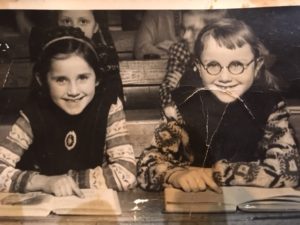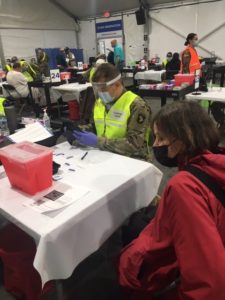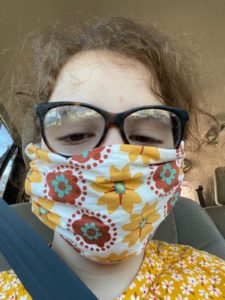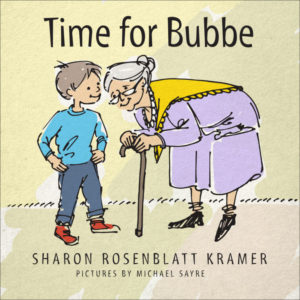Saturdays with Seniors: Carol in 3D
March 27, 2021 • 10 Comments • Posted in guest blog, memoir writing, writing prompts
A 1-1/2 minute clip from Carol’s son Steven’s labor of love.
I am pleased to introduce Carol Rosofsky as our Saturdays with Seniors guest blogger today. A consultant at the Chicago Humanities Festival, Carol was once married to Chicago artist Seymour Rosofsky, who was part of a cluster of returning soldiers dubbed the “Monster Roster” after seeing the horrors of World War II and studying at the Art Institute of Chicago and University of Chicago on the GI Bill. They preceded to influence Chicago’s Hairy Who Movement.
Carol is a longtime member of the memoir class I lead for Village Chicago and has written a number of memorable essays about life with Seymour, and then later about marrying civic leader Robert “Bud” Lifton 30 years ago on a ski vacation in Canada with their seven kids in attendance. That memoir-writing class is on spring break now, and for their last class of the winter session I asked them to use 500 words to tell us if –- and how — their life has changed over this past year. Here’s the honest, thoughtful and sweet essay Carol came back with.
by Carol Rosofsky
It’s been a year — one very tough year dotted with few memorable highlights, the monotony, the fear, the routine, the lethargy, pajamas, sweatpants…and then there’s that moment after lockdown kicked in when we realized the scale of disruption ahead. This wouldn’t be weeks, but months. A year.
To get through it I thought deeply about renewing or learning something that might come in handy to distract myself for the long term. What a great time to immerse myself in a master project of some sort, Something deep, thoughtful, requiring a significant amount of uninterrupted time to think through and execute.
In my head this was a perfect response to facing the reality and the dire circumstance at hand: a long cold winter, quarantined. I refurbished the old Singer sewing machine and resurrected the quilts and quilt books that inspired me as a first-time maker 25 years ago. But threading the needle and the bobbin with 86-year-old eyes was so challenging I only managed to semi-finish a part of one quilt and pillowcase and have been unable to locate a long arm quilter to follow up with the finish .
Next I hoped to revive the jazz piano lessons I had been taking at Merit Music before COVID, but online and not in person was not fulfilling. Cooking, a former passion, also lost it’s magic when it had to occur so often every day, plus the cleanup. I ended up ordering and stashing quarts and quarts of organic soups produced by Green City Market’s Bushel & Peck’s vendor, delivered directly to my door every other week. .
These projects soon revealed themselves in the form of no real inspiration or motivation, just coping elements that I’ve found tend to come in handy when attempting to create — and sustain — hope.
After a period of looking at blank projects and frustration, I made a conscious decision to allow myself to try to feel OK about “just getting by.” I’ve read a lot of studies saying that it’s going to be hard to have good memories of this past year (it all still feels like “Groundhog Day”) but I’m proving them wrong by ending this essay on a few upbeat, standout moments.
Number 1
This November in Lincoln Park, at Diversey and Stockton, near Bacinos’s Pizza, the news exploded in the air that Joe Biden and Kamala Harris were just confirmed. As the staff spread out into the crowd around Bacino’s everyone in the park started screaming and dancing, high-fiving, filling the air with unmitigated joy. It was the first time in a long time I felt genuinely three-dimensional and excited in months, resisting the temptation to hug every stranger in the crowd, mask or not.
Number 2
This past December, when son Steven finally invited the entire family to view his final updated version of the 1-and-a-half-hour documentary he’d been working on since 2004. The film is an homage to his artist father who died unexpectedly at 56 in 1981, a couple of years after Steven finished film school at NYU.
For over 17 years Steven worked on the film, interviewing family members many times over in various settings; also colleagues, friends, critics, artists, gallery owners, curators and museum personnel without showing his work-in-progress to anybody.
It was thrilling to see, over time, who we were then, who we are now. The good, the bad, the edited and unedited, the film is an homage and wonderful document for a lifetime.
Impromptu Number 3, added virtually after listening to all the class essays Monday
.The Wall Street Journal published a piece saying that in this past year memoir-writing has become an epidemic.



